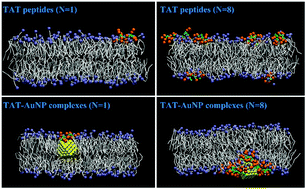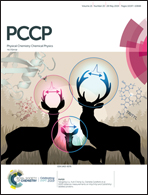Molecular mechanism of HIV-1 TAT peptide and its conjugated gold nanoparticles translocating across lipid membranes†
Abstract
The trans-acting activator of transcription (TAT) peptide, which is derived from human immunodeficiency virus-1 (HIV-1), has been widely used as an effective nanocarrier to transport extracellular substances into cells. However, the underlying translocation mechanism of TAT peptide across cell membranes still remains controversial. Besides, the molecular process of TAT peptide facilitating the transport of extracellular substances into cells is largely unknown. In this study, we explore the interactions of TAT peptides and their conjugated gold nanoparticles with lipid membranes by coarse-grained molecular dynamics simulations. It is found that the TAT peptides can hardly penetrate through the membrane at low peptide concentrations; after the concentration increases to a threshold value, they can cross the membrane through an induced nanopore due to the transmembrane electrostatic potential difference. The translocation of TAT peptides is mainly caused by the overall structural changes of membranes. Furthermore, we demonstrate that the translocation of gold nanoparticles (AuNPs) across the membrane is significantly affected by the number of grafted TAT peptides on the particle surface. The transmembrane efficiency of AuNPs may even be reduced when a small number of peptides modify them; whereas, when the number of grafted peptides increases to a certain value, the TAT–AuNP complex can translocate across the membrane in a pore-mediated way. Based on our findings, an effective strategy has been proposed to enhance the delivery efficiency of AuNPs. The present study can improve our understanding of the interactions between TAT peptides and cell membranes; it may also give some insightful suggestions on the design and development of nanocarriers with high efficiency for the delivery of nanoparticles and drugs.

- This article is part of the themed collection: 2019 PCCP HOT Articles


 Please wait while we load your content...
Please wait while we load your content...